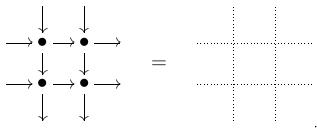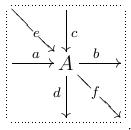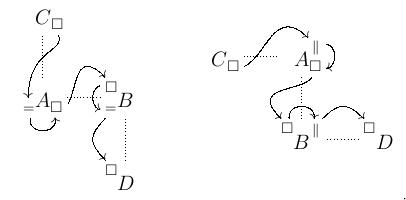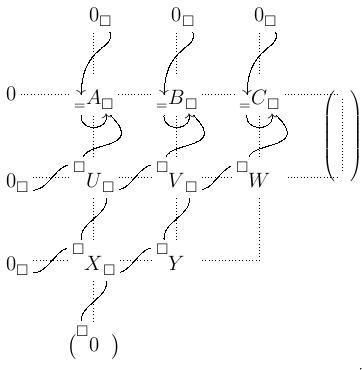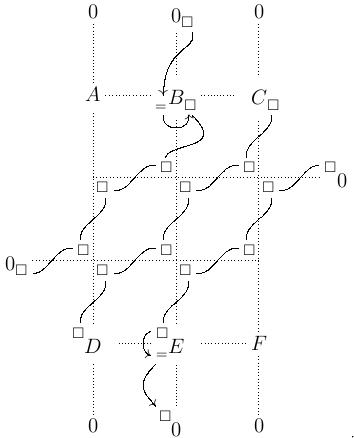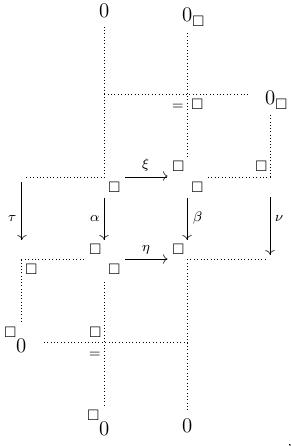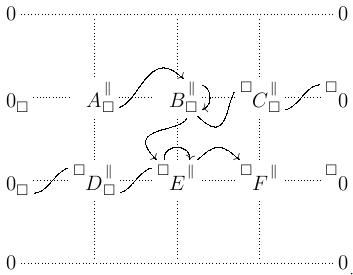Salamander lemma
I first wrote up this post for the Secret Blogging Seminar.
A couple of years ago, George Bergman gave me a copy of a fun preprint that he never got around to preparing for publication. There is now a preprint on the arXiv. It starts
The "magic" of diagram-chasing consists in establishing relationships between distant points of a diagram---exactness implications, connecting morphisms, etc.. These "long" connections are in general composits of "short" (unmagical) connections, but the latter, and even the objects they join, are frequently not visible in the diagram-chasing proof. We attempt to remedy this situation here.
If you don't like diagram chases, it's likely that you still won't like them once you know the Salamander lemma. The salamanders chase the diagrams for you, but you still have to chase the salamanders. I think the salamander proofs are easier to explain (once you know the Salamander lemma), and it's easier to see where you use the hypotheses. For example, it is totally clear that the argument for the $3\times 3$ lemma can prove the "$20\times 20$ lemma" as well.
Notation
A bicomplex in an abelian category is a complex of complexes, i.e. an infinite grid of objects and arrows in which all the rows and columns are complexes (two consecutive arrows compose to zero) and all the squares commute. If we have a finite bicomplex, then we can always extend it by either adding zeros or various kernels and cokernels (if we want some exactness conditions). Since everything I say will take place on a bicomplex background, I'll adopt the convention that all the arrows in the bicomplex go to the right and down, and I'll draw the arrows in the bicomplex as dotted lines:
Given an object $A$ in a bicomplex,
we define the vertical homology $A^\parallel:=\ker d/\mathrm{im}\, c$, the horizontal homology ${}_=A:=\ker b/\mathrm{im}\,a$, the receptor ${}^\square A:=\displaystyle\frac{\ker b\cap \ker d}{\mathrm{im}\, e}$, and the donor $A_\square := \displaystyle\frac{\ker f}{\mathrm{im}\,a+\mathrm{im}\,c}$. Note that if $A=0$, then all of these subquotients are zero.
Recall that to define a morphism $X/Y\to Z/W$, it is enough to define a morphism $X\to Z$ such that the image of $Y$ is contained in $W$. This gives us four obvious maps (called intramural maps) induced by inclusions: ${}^\square A\to A^\parallel$, $A^\parallel\to A_\square$, ${}^\square A\to {}_=A$, and ${}_=A\to A_\square$. We also see that for any morphism $A\to B$ in a bicomplex, we have an obvious extramural map $A_\square\to {}^\square B$.
Salamander lemma
If $A\to B$ is a horizontal arrow in a bicomplex, then there is a six term exact sequence $C_\square\to {}_=A\to A_\square\to {}^\square B\to {}_=B\to {}^\square D$ as shown on the left.
The morphism $C_\square \to {}_=A$ is the composition of the extramural map $C_\square \to {}^\square A$ and the intramural map ${}^\square A\to {}_=A$. The morphism ${}_=B\to {}^\square D$ is similar. If $ A\to B$ is a vertical arrow, then we get the six term exact sequence on the right. In either case, I'll call this the salamander centered at $A\to B$. The proof of the Salamander lemma is totally obvious in any abelian category where the objects have elements; you just unwind the definitions. You can reduce to this case in the usual way (see chapter VIII, section 4 of Categories for the Working Mathematician).
Special case: if the row (resp. column) containing the morphism $A\to B$ is exact at $A$ and $B$, then the horizontal homologies ${}_=A$ and ${}_=B$ (resp. vertical homologies $A^\parallel$ and $B^\parallel$) are zero, so the extramural map $A_\square\to {}^\square B$ is an isomorphism.
3×3 lemma (or 9 lemma)
If we have three rows and three columns as shown below, with all three columns exact, and the bottom two rows exact (at $U$, $V$, $X$, and $Y$), then the first row is exact (at $A$ and $B$). Moreover, if we have the stuff in parentheses (imposing horizontal exactness at $W$ and vertical exactness at $X$), then the top row is exact at $C$.
To prove this, we need to show that the horizontal homologies ${}_=A$, ${}_=B$, and ${}_=C$ are zero. Using the salamander centered at $B\to C$, we see that ${}_=B$ is sandwiched between $0_\square=0$ and $ B_\square$ in an exact sequence. Repeatedly applying the special case (using the exactness hypotheses we have), we see that $B_\square\cong 0_\square=0$, as illustrated, so ${}_=B$ is zero. Similarly, we see that ${}_=A$ and (given the appropriate hypotheses) ${}_=C$ are zero as well. Strictly speaking, I should put $\mathrm{coker}(V\to Y)$ underneath $Y$ so that I use the special case to get the isomorphism $ V_\square \cong {}^\square Y$. Since $U$ surjects onto $X$, the image of $X$ in $Y$ lies in the image of $V$, so we still have a bicomplex when we do this.
Snake lemma
If we have the bicomplex below, with the three columns exact, and the middle two rows exact, then there is a six term exact sequence $A\to B\to C\to D\to E\to F$.
We prove that ${}_=B$ and ${}_=E$ are zero as before. Now we have to construct a "connecting morphism" $C\to D$ making the desired six term sequence exact. This is equivalent to producing an isomorphism $ \mathrm{coker}(B\to C)\cong \ker (D\to E)$. Unravelling the definition, we have that $ \mathrm{coker}(B\to C)=C_\square$ and $\ker(D\to E)={}^\square D$, and we have an isomorphism between these using several applications of the special case.
Four lemma
If we have the bicomplex below, with the columns exact and the middle two rows exact, then $\xi(\ker \alpha)=\ker \beta$ and $\mathrm{im}\, \alpha = \eta^{-1}(\mathrm{im}\, \beta)$. In particular, if $\alpha$ is injective, then so is $\beta$, and if $\beta$ is surjective, then so is $ \alpha$.
The desired result is equivalent to proving that the top and bottom rows are exact (i.e. that the two horizontal homologies in the picture are zero), which I'll leave as an exercise (it should be very easy; the picture has everything you need).
Long Exact Sequence in homology
This one is a little different from the others. So far, we've used the special case, together with "half salamanders". This time we'll use a "whole salamander". If we have the bicomplex below, with the rows exact, then there is a six term exact sequence $ A^\parallel\to B^\parallel\to C^\parallel\to D^\parallel\to E^\parallel\to F^\parallel$.
Looking at the salamander centered at $A\to D$, we have $0=0_\square\to A^\parallel\to A_\square\to {}^\square D\cong 0$, so $A^\parallel\cong A_\square$. Applying the same argument "one level down," we have that $D^\parallel\cong D_\square$. Looking at the salamander centered at $C\to F$, we have $0\cong C_\square\to {}^\square F\to F^\parallel\to {}^\square 0=0$, so ${}^\square F\cong F^\parallel$. Applying the same argument "one level up," we get that ${}^\square C\cong C^\parallel$. Now we look at the salamander centered at $B\to E$, which is $A_\square\to B^\parallel\to B_\square\to {}^\square E\to E^\parallel\to {}^\square F$. Using the isomorphisms we just talked about (along with the isomorphisms $D_\square\cong {}^\square E$ and $B_\square \cong {}^\square C$), we get the desired six term exact sequence $A^\parallel\to B^\parallel\to C^\parallel\to D^\parallel\to E^\parallel\to F^\parallel$.
